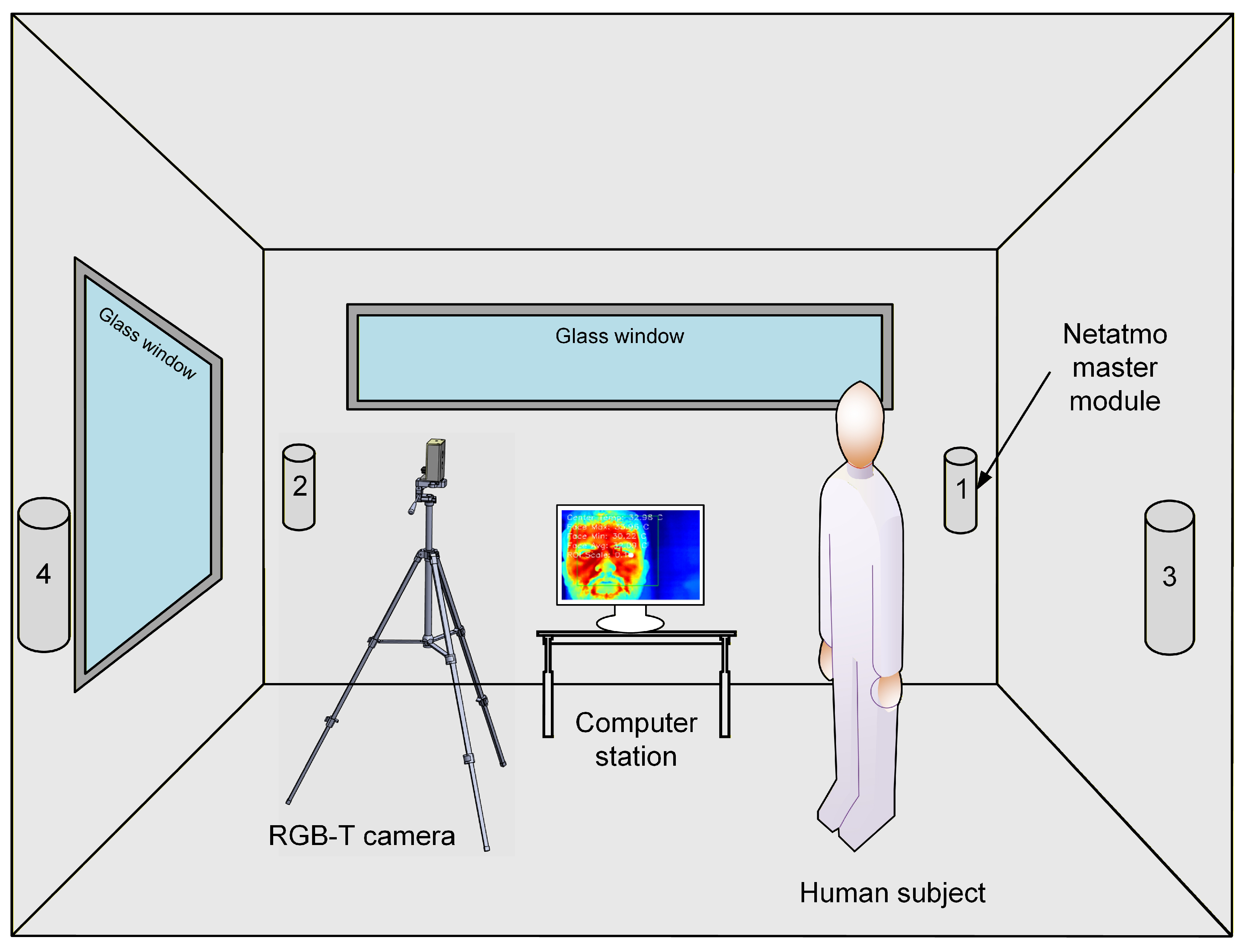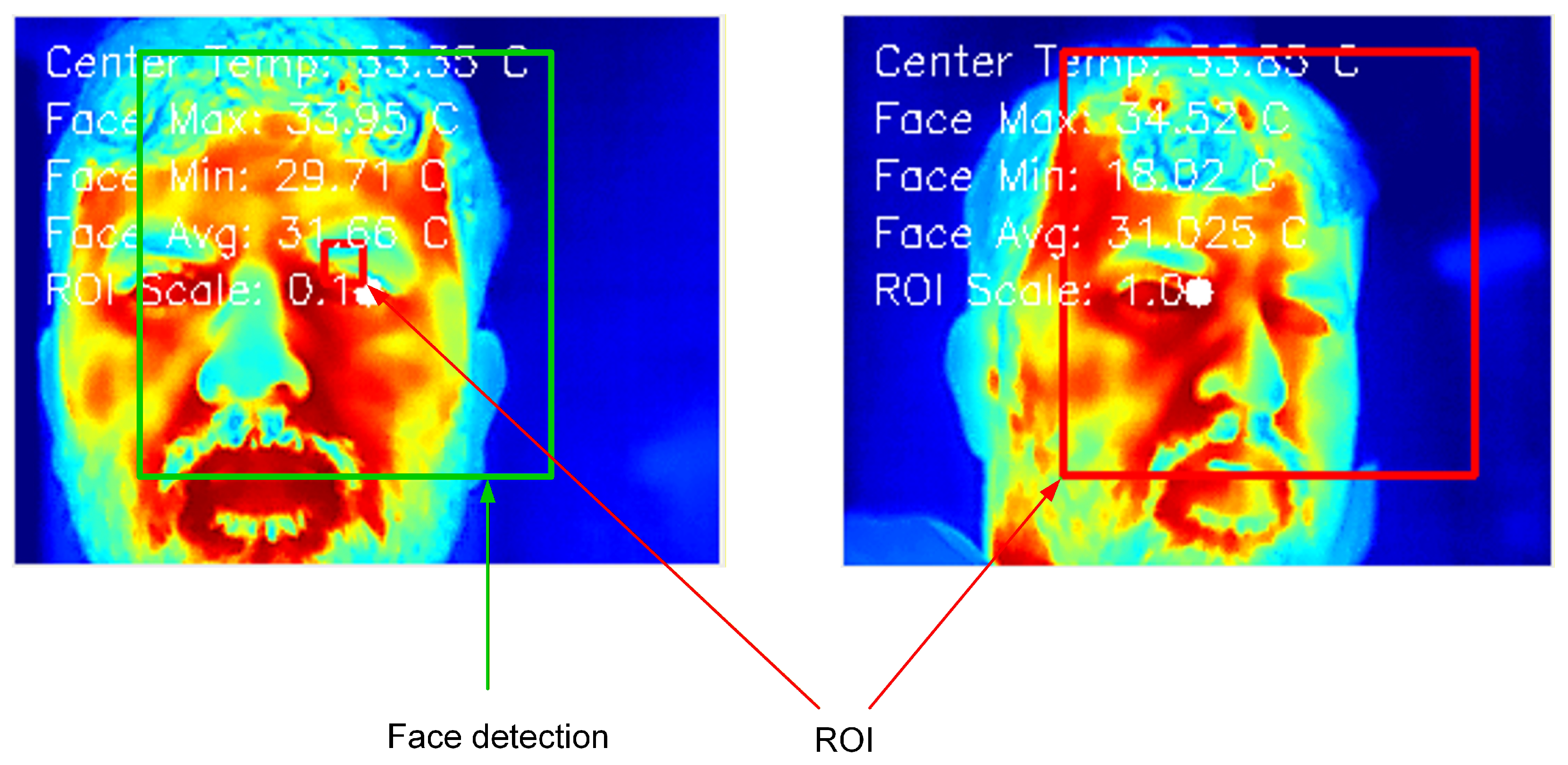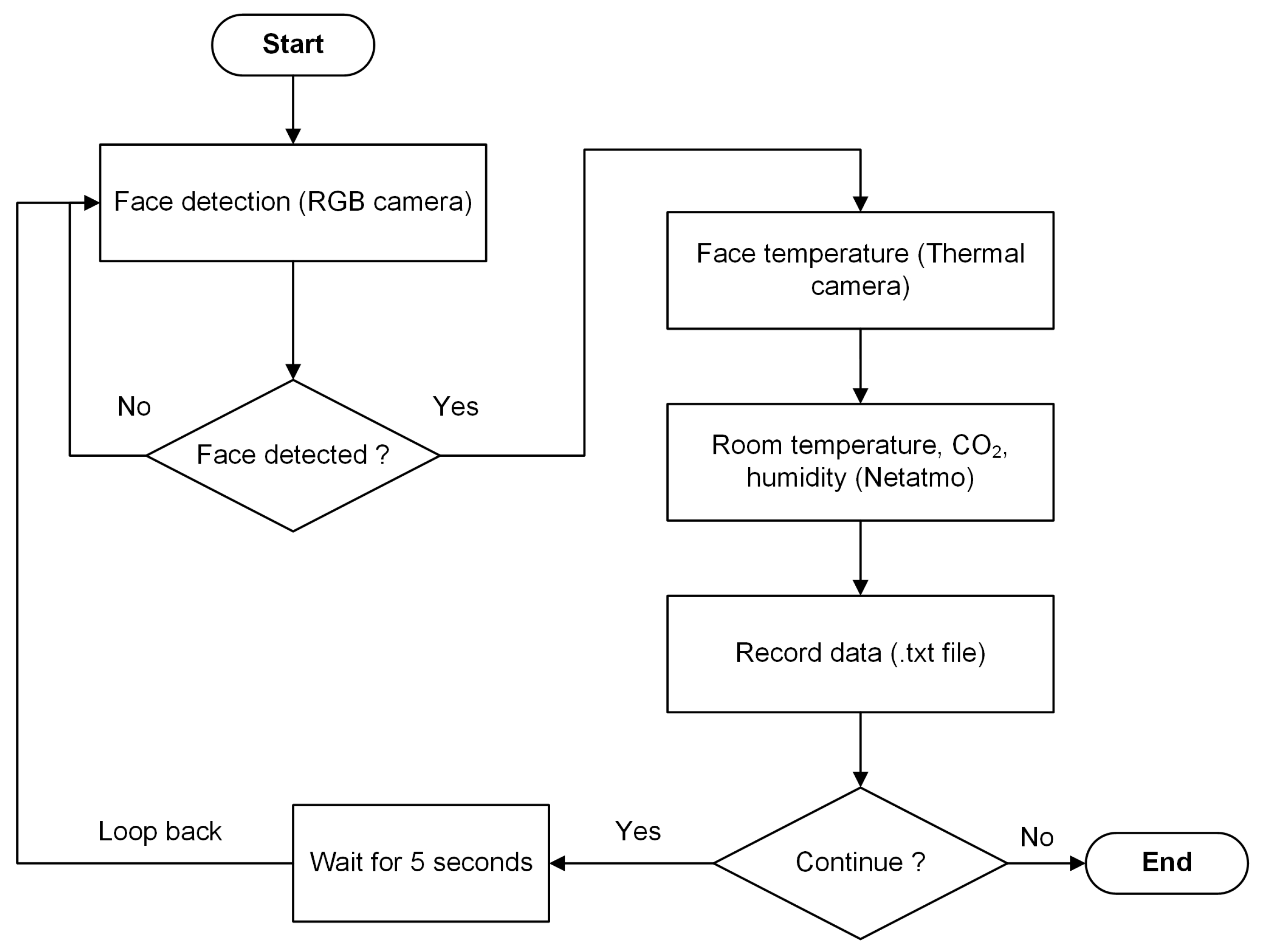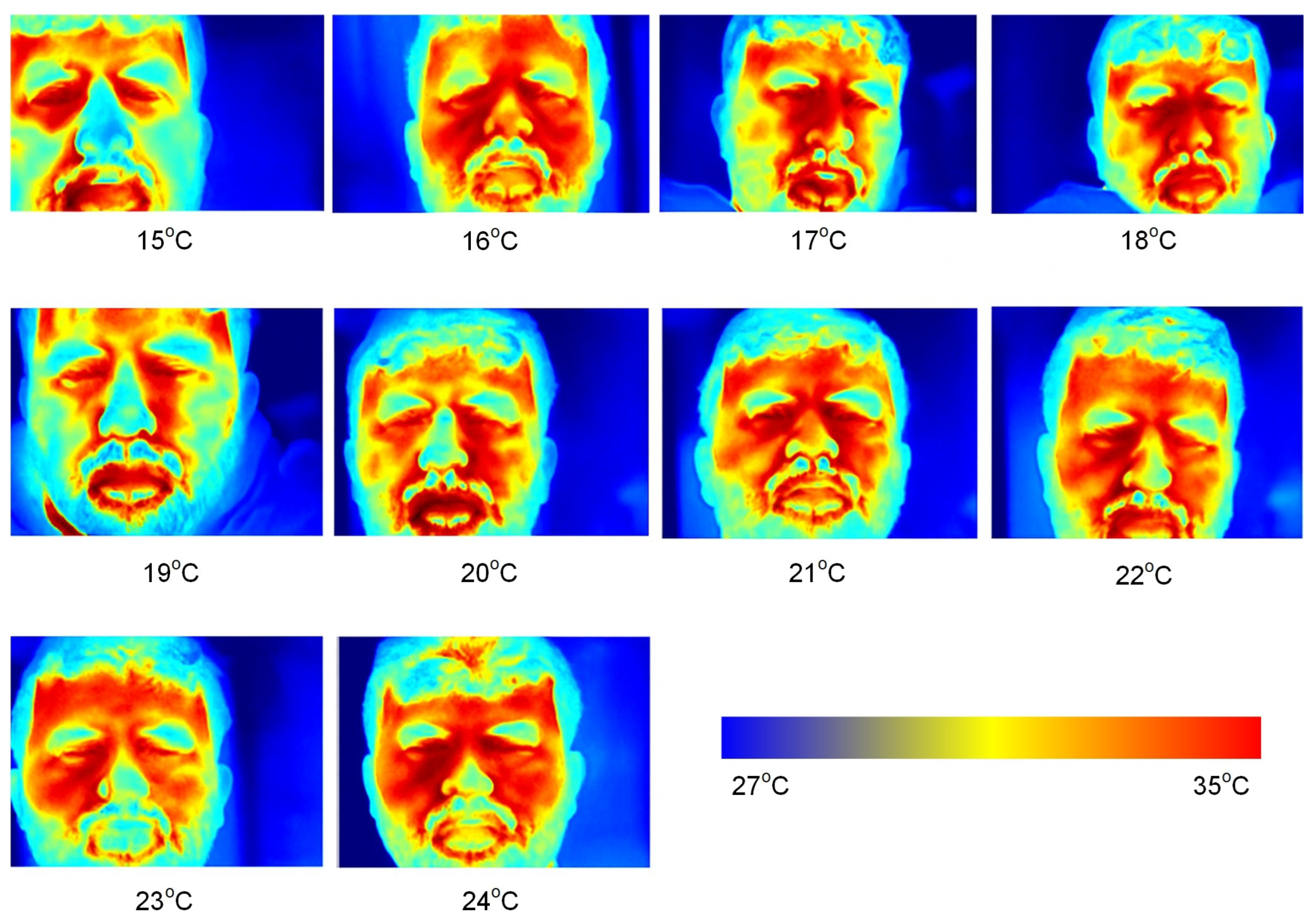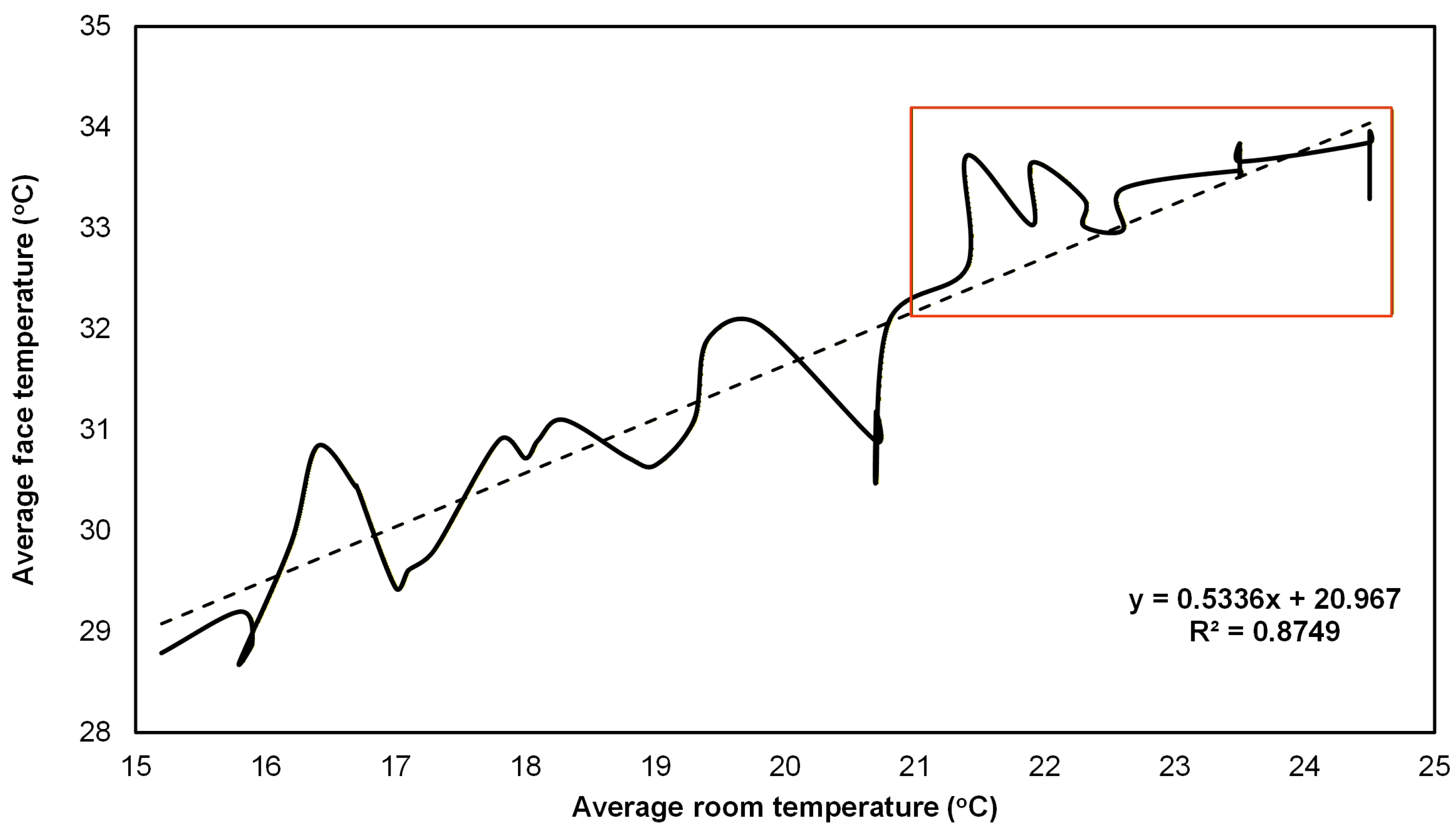1. Introduction
Thermal comfort is essential for building occupants’ productivity, mental state, and well-being [
1]. Modern building designs often account for thermal comfort by applying Fanger’s Predictive Mean Vote (PMV) model to calculate the required comfort levels for occupants [
2]. However, Fanger’s explicit model requires customization to meet occupants’ thermal comfort needs in real time [
3,
4].
Researchers have proposed using thermal cameras to collect real-time temperature data from occupants, which can then be used to train AI models to operate the building’s Heating, Ventilation, and Air Conditioning (HVAC) systems in accordance with occupants’ comfort requirements. Existing room temperature measurement solutions, however, have certain limitations. Most rely on RTD (Resistance Temperature Detector) wall sensors, which are prone to inaccuracies due to their physical installation locations and exposure to other heat sources, such as window glazing or electronic equipment [
5,
6,
7,
8]. Similarly, gadgets and occupant feedback are often inaccurate, either because of limited temperature measurement range or because feedback is influenced by personal feelings and emotions, resulting in an unreliable database for training AI models [
9,
10,
11,
12].
Thermal cameras are preferred for real-time occupant temperature measurement. However, they are generally expensive, prompting many researchers to develop customized thermal cameras [
13]. With limited building budgets, these custom solutions allow researchers to adapt the cameras to specific building designs and geographic locations.
Given this context, this paper presents a solution for measuring occupants’ temperature using a customized, non-contact thermal camera. The camera is programmed to capture temperature from commonly exposed body parts, specifically the facial skin. A relationship will be established between wall-mounted RTD sensors and the thermal camera to identify facial comfort temperature and predict overall occupant comfort.
1.1. Concept of Calculating Thermal Comfort in Modern Buildings
In the 1970s, Fanger proposed two models for assessing and predicting thermal comfort in indoor environments: the Predicted Mean Vote (PMV) and the Predicted Percentage Dissatisfied (PPD). The PMV quantifies the average thermal sensation of a large group of people on a seven-point scale, ranging from −3 (cold) to +3 (hot), with 0 representing neutral. PPD estimates the percentage of people likely to feel uncomfortable in a given environment. The design parameters for both models include air temperature, mean radiant temperature, relative humidity, air velocity, clothing insulation, and metabolic rate for a given environment. Both models are widely used in building design and are incorporated in ASHRAE Standard 55 [
14] and ISO 7730 [
15] as international thermal comfort standards. However, a key limitation is that all design parameters are calculated based on fixed values and do not reflect real-time variations in thermal comfort [
16].
1.2. Skin Temperature Relationship with Indoor Comfort
Studies have shown that human skin temperature is closely related to indoor comfort, which is not uniform and can vary over time depending on indoor air parameters, metabolic activity, and clothing. Research indicates that skin temperature is a strong indicator of occupants’ perceived thermal comfort, and certain body parts, such as the face, can help identify comfort levels [
17,
18].
The inner core body temperature for a healthy human is approximately 36.7 °C. To maintain this core temperature, the body engages in several automated responses, adjusting blood flow under the skin to regulate heat [
5,
11,
19,
20]. These changes in blood flow manifest as sensations such as warmth, sweating, cold, or shivering, which are reflected in skin temperature and thus indicate the occupant’s comfort level [
21,
22,
23].
In one study, an experiment was conducted to examine the relationship between skin temperature and occupant comfort using wireless temperature sensors (thermistors) attached to multiple body locations, including the forehead, chest, upper arm, thigh, calf, and hand. Skin temperature was continuously monitored alongside environmental measurements and occupants’ subjective comfort assessments. The results confirmed that skin temperature is a reliable predictor of thermal sensation and can be used to assess indoor comfort in buildings [
24].
Table 1 summarizes the observed relationship between indoor air temperature and mean skin temperature, illustrating how changes in the indoor environment correspond to variations in occupants’ skin temperature and, consequently, their perceived thermal comfort.
Clothing, metabolic rate, air velocity, humidity, radiant temperature, and air temperature all influence thermal comfort for occupants. Indoor air quality (IAQ) parameters, such as CO
2 (ppm), also play a role in comfort [
2,
16,
25,
26]. Frontczak and Wargocki note that achieving optimal indoor comfort requires a holistic approach, as occupant comfort results from the combination of multiple factors [
27]. During the experiment, CO
2 (ppm) and humidity (%RH) will be monitored to observe their effect as indoor air temperature changes.
1.3. Current Methods of Measuring Indoor Room Temperature
The most common method to measure and control indoor environments is through wall-mounted temperature sensors. These sensors are typically RTD types, which measure the resistance of the sensor’s surface to determine the indoor temperature. They are integrated into the Heating, Ventilation, and Air Conditioning (HVAC) system as part of a closed-loop feedback mechanism. The wall-mounted sensors measure room temperature and send feedback via programmable logic controllers (PLC) to modulate the HVAC system according to predefined parameters.
This approach is prone to inaccuracies. The sensor’s location can produce false readings if installed near windows or close to heat-generating sources such as TVs or printers. In other words, the wall-mounted RTD sensor controls the indoor environment based on its surface temperature, which may not reflect the actual room conditions [
28].
In addition to wall-mounted temperature sensors, modern smart-building systems increasingly deploy distributed Internet-of-Things (IoT) sensor networks for monitoring ventilation performance, indoor air pollutants, and occupancy behavior [
29]. These systems typically track variables such as CO
2 concentration, humidity, and airflow patterns to support ventilation control and indoor-air-quality management, rather than measuring individual occupants’ thermal state. Such approaches provide environmental context but do not directly assess personal thermal comfort, motivating alternative sensing techniques such as non-contact facial temperature monitoring.
Another method for regulating indoor temperature is through occupant-based monitoring devices such as smart watches. With advancements in medical technologies for skin temperature measurement, researchers have proposed solutions to measure occupants’ sweat rates via smart watches. This data can then be used to modulate HVAC operation through IoT-based communication between the watch and the control system. Sweat rate sensors operate by integrating miniaturized thermo-pneumatic actuators, which measure humidity evaporation caused by sweat. These sensors typically include two components: a humidity chamber for collecting sweat-induced humidity and a humidity sensor within the chamber to measure the collected moisture [
18].
Natural ventilation-based sweat sensors are categorized into open and closed chamber types. Open chamber types include two humidity sensors, with one open to measure the humidity difference, while the generated sweat naturally ventilates through the open end. These are highly sensitive to even gentle airflow (<0.5 m/s), limiting their use in mobile monitoring applications. Closed chamber types use a single humidity sensor to measure the rate of humidity rise while in contact with the skin [
30]. While effective for individual occupants, this solution cannot ensure thermal comfort for those not wearing the watch.
A third method relies on direct occupant feedback. This is commonly done during building fine-tuning, typically three to six months after commissioning or during routine maintenance [
31]. However, this method is highly subjective, as occupant responses are influenced by stress, well-being, and mental state [
32,
33,
34].
Since the COVID-19 pandemic, thermal imaging has emerged as a method for measuring facial temperature. Nevertheless, researchers have achieved limited success due to challenges in face detection, calibration, and environmental variables, which affect measurement accuracy [
35,
36,
37,
38,
39,
40].
This paper focuses on non-contact facial temperature measurement using thermal images and calibrating these thermal readings against room temperature obtained from wall-mounted sensors. AI-driven comfort models require diverse and reliable field data; however, wearable sensors and RTD-based measurements can suffer from practical limitations such as user compliance, placement constraints, motion artifacts, and location-dependent inaccuracies. These factors reduce real-world data robustness, making non-contact sensing a promising alternative.
To address this gap, we propose a low-cost RGB-T thermal imaging system integrated with a Raspberry Pi to continuously measure facial skin temperature and align these measurements with ambient indoor temperature. This approach provides spatial thermal information without requiring user-mounted devices and supports automated region-of-interest detection, offering a practical, occupant-centric solution for indoor comfort studies.
To guide this study, the following research questions (RQs) are addressed:
RQ1: Can a low-cost RGB-T thermal imaging system reliably measure facial skin temperature in indoor environments?
RQ2: What is the relationship between room air temperature and facial skin temperature under controlled conditions?
While this paper focuses on measurement and calibration, these findings also lay the groundwork for future research on integrating facial temperature sensing with HVAC control strategies.
2. Proposed System Design
Previous studies have shown that indoor temperature can be measured in multiple ways; however, occupant thermal comfort remains a concern, as highlighted in
Section 1.3, which identifies limitations in the discussed techniques. To address this, an experiment was conducted to establish the relationship between facial temperature, measured using a thermal camera, and indoor temperature, recorded by RTD sensors. The Topdon Thermal Camera TS001 (Topdon Technology Co., Ltd., Shenzhen, China) was used to measure facial temperature.
Thermal cameras are limited in detecting objects, as they capture heat signatures rather than visible light images. As a result, fine details of an object are often too complex to be accurately captured by a thermal image. For face detection, the Grandstream GUV3100 (Grandstream Networks, Inc., Boston, MA, USA) was employed, while the Netatmo indoor modules (Netatmo S.A., Boulogne-Billancourt, France) were used to measure indoor air temperature, CO
2, and humidity. The combination of the webcam and thermal camera is referred to as the RGB-T camera (
Figure 1).
Both cameras are aligned so that the region of interest remains consistent, as shown in
Figure 2. The dimensions of the area of interest are set during the calibration process to ensure that the occupant’s face can be accurately detected in each frame.
A Raspberry Pi 5 was programmed with an algorithm to detect a face. Once a face is detected, the algorithm triggers the thermal camera to measure facial temperature and the Netatmo sensors to record indoor temperature, CO
2, and humidity. The readings are recorded in a text file whenever a face is detected. A relationship is then established between the Netatmo sensor and the Topdon thermal camera readings. The positions of the cameras and Netatmo indoor sensors remain fixed throughout the experiment.
Figure 1 and
Figure 3 illustrate the camera design and experimental setup.
Several alternative sensing approaches were evaluated. Low-cost thermopile devices (e.g., AMG8833 (Panasonic Corporation, Osaka, Japan)) were initially considered due to their affordability, but they provide only single-point temperature readings and therefore lack the spatial resolution needed to monitor multiple occupants or detect local facial thermal variations. Wearable skin-temperature sensors and low-cost IR spot sensors reported in literature can provide accurate skin temperature readings, but they require user compliance and are impractical for passive indoor comfort monitoring. Higher-end thermal cameras (e.g., FLIR A20V (FLIR Systems Inc., Wilsonville, OR, USA)) offer superior accuracy but are expensive and, in some cases, discontinued or unsupported.
The proposed system adopts a low-cost RGB-T camera platform combined with a Raspberry Pi for real-time acquisition, spatial temperature mapping, and automated ROI-based facial temperature extraction. This enables continuous non-contact temperature measurement with sufficient spatial resolution to support indoor comfort studies, distinguishing our approach from both single-point thermopile devices and wearable-based methods.
Four wall-mounted Netatmo temperature sensors are installed to accurately monitor the room temperature, as shown in
Figure 3. The human body’s inner core temperature is approximately 36.7 °C, which is necessary for normal organ function. To maintain this core temperature, skin temperature across different body parts must be regulated. This experiment focuses on average facial temperature, measured using the Topdon TS001 thermal camera.
Studies indicate that, for indoor environments, thermal comfort corresponds to facial temperatures in the range of 32 °C to 34 °C. When facial temperature rises above 35 °C, occupants may begin to feel warm or hot, whereas temperatures below 32 °C may lead to sensations of coolness or cold [
17,
18].
Figure 4 presents the sequential workflow for implementing a facial temperature monitoring system.
The face detection model was trained using an open-source deep learning library called Dlib. Dlib employs Histogram of Oriented Gradients (HOG) features along with a linear Support Vector Machine (SVM) classifier, making it suitable for real-time face-detection applications. In addition, Dlib includes a deep learning model for face embeddings, which can be used for face identification and verification tasks, such as creating customized indoor comfort models for individuals. For more accurate face detection, Dlib leverages a conventional neural network (CNN) technique [
41]. The primary advantage of using Dlib is that it is lightweight and fast, making it well-suited for deployment on a Raspberry Pi 5.
A Python (3.11) script was developed to measure average facial temperature using the Topdon TS001 thermal camera. The core communication logic, diagnostics, and data parsing routines were adapted from the open-source PyThermalCamera repository by Les Wright, originally designed for the Topdon TC001 camera [
42]. The script was further extended to include data saving, Netatmo sensor integration, and facial recognition using the DLib library.
Both cameras were aligned to focus on the same region of interest (ROI).
Table 2 summarizes the characteristics of both cameras. The ROI and cropping were adjusted to ensure that the frames from both cameras matched accurately.
For calibration purposes, a region-of-interest (ROI) function was implemented, allowing the average facial temperature measurement area to be adjusted by scaling the side length of the square ROI between 0.1 and 1. The ROI size is defined relative to the bounding box detected by the face detection algorithm (i.e., an ROI of 1 corresponds to the full bounding box). A smaller ROI provides more accurate results, as the maximum and minimum temperatures are measured within a reduced area. The average facial temperature is calculated as the mean of the maximum and minimum temperatures recorded within the ROI.
Figure 5 illustrates the difference between ROIs with scaling factors of 1 and 0.1, where the latter corresponds to an area 100 times smaller. The red square represents the ROI in the thermal image, while the green square indicates the bounding box around the face detected by the RGB camera. An offset feature was also incorporated for the maximum and minimum temperatures, which was set to 0 °C in the experiment.
Netatmo readings were collected simultaneously with face detection. These measurements were integrated into the logic via the Netatmo API. Whenever the webcam detects a face within the frame, both the average face temperature and Netatmo sensor measurements are recorded with time and date in a text file, which is updated every 5 s.
Figure 6 presents the corresponding logic flow chart.
Calibration of the Topdon TS001
Prior to the experiment, the Topdon TS001 was checked for temperature accuracy. Calibration was performed against a Sentry TS663 (Sentry Optronics Corp., Ban-Ciao (Taipei), Taiwan, R.O.C.) infrared temperature sensor using the Hierarchical Linear–Polynomial Mapping (HLPM) method. Measurements are traceable to the SI via the Measurement Standards Laboratory (MSL), New Zealand. A blackbody with a 35 mm aperture (0–90 °C range) was used; ambient conditions were maintained at 20 ± 2 °C and instrument readability was 1 °C. For the TS001 calibration, temperatures from the TS001 and TS663 were recorded at five setpoints between 30 °C and 35 °C, with both instruments positioned 0.5 m from the target and an indicated readability of 0.5 °C. Measured values were within the ±1 °C tolerance.
At a camera-to-subject distance of 0.5 m, the thermal camera field-of-view covers approximately 0.53 m × 0.38 m (H × V), while the RGB camera covers approximately 0.78 m × 0.44 m. This FOV ensures full facial coverage in both modalities, providing sufficient resolution for accurate region-of-interest–based temperature extraction.
3. Results and Discussion
The experimental setup was tested over a period of one week to ensure that the temperature readings remained within the expected range. The test was carried out multiple times to ensure that the results were consistent for validation purposes. Each test lasted 40 min, with the participant seated in front of the camera to ensure proper face detection while the thermal camera recorded the average facial temperature. The distance between the participant and the thermal camera/web camera was maintained at 0.5 m in a sitting position. The camera tripod was set at a height of 1.2 m. The age of the participant was 36 years and a slight beard was preferred to see the thermal affect and notice variation in temperature on the facial measurements. As shown in
Figure 3, windows were opened or closed, and the heat pump setpoint temperature was adjusted to modify the room temperature. The wall-mounted Netatmo sensors recorded these temperature changes. Once the room temperature stabilized and the occupant adapted to the indoor environmental conditions, the average face temperature was measured, and thermal images of the face were captured. The room dimensions were 3 m (L) × 3 m (W) × 2.4 m (H). The ambient temperature for the room was in the range of 17 °C to 19 °C. Before the start of the experiment, the ambient temperature for the room was controlled to 15 °C by opening the windows as the outside ambient temperature was lower than the room temperature. Once the room temperature was set to 15 °C, the windows were closed, and an electric heater (2 kW) was used to gradually increase the room temperature to 25 °C. The entire process took approximately 40 min, and the results were recorded.
During the testing period, the outside ambient temperature ranged from 1 °C to 6 °C at night and 8 °C to 13 °C during the day. The participant wore casual clothing. The results were recorded in a text file every 5 s, resulting in 480 measurements over each 40 min test.
Table 3 summarizes the results, which were also recorded at 5 min intervals during the testing period.
During the test, the participant’s facial temperature changed in response to variations in room temperature. The thermal images captured at each degree of change reflected these variations. On the thermal scale, yellow indicates cooler regions of the face, while red indicates warmer areas. According to Fanger’s PMV model parameters, air velocity and clothing insulation remained constant throughout the experiment. However, relative humidity, air temperature, mean radiant temperature, and metabolic rate varied.
Although real-time metabolic rate was not measured in this experiment, changes in metabolic rate can be inferred from the facial thermal images, as metabolic rate corresponds to the rate at which the body produces heat. The shifting yellow and red regions on the face indicate biological responses to maintain core temperature, contributing to occupant comfort.
In Fanger’s model, mean radiant temperature is typically calculated from the surface temperatures of the environment without considering skin temperature. However, recent research supports combining environmental parameters with physiological measurements, such as skin temperature, to achieve more accurate and personalized assessments of thermal comfort [
43,
44].
In this experiment, environmental temperatures were not calculated; the focus was solely on analyzing real-time changes in facial temperature to determine occupant comfort.
Figure 7 shows screenshots of the participant’s thermal images at different room temperatures. The thermal images illustrate that as room temperature decreases, the red regions on the face (indicating higher temperature) diminish while yellow regions (indicating lower temperature) appear. An increase in yellow regions corresponds with the participant feeling cold, while an increase in red regions corresponds with the participant feeling warm.
The following factors must be considered when analyzing the results, as they can affect the accuracy of the data presented:
Accuracy of the thermal measurement via the thermal camera;
Accuracy of the indoor temperature sensor;
Location of the sensors;
Participant distance from the camera;
Metabolic rate of the participant.
During the experiment, the participant’s position, as well as the locations of the thermal camera and indoor temperature sensors, were kept consistent. However, the accuracy of the equipment must still be considered. With the limited budget for this experiment, results could have been more precise if devices with higher accuracy and lower tolerance had been used. According to the datasheet for the Topdon TS001 thermal camera, the accuracy is ±3 °C [
45]. Other limitation that need to be considered, while analyzing the results is metabolic rate. For the research purpose, metabolic rate measurement was not considered as at the time of the experiment, we did not have the setup to measure it. However, in order to keep the metabolic rate consistent, the participant measured data was collected in sitting conditions (1.0–1.2 m) during the complete experiment [
46]. The participant was given the same set of clothes during the experiment and his distance from the measuring device was kept constant. The experiment was conducted during night time to avoid any influence of window glare/reflection.
Figure 8 shows the plots for all Netatmo sensors, while
Figure 9 shows the average room temperature and its relation to average facial temperature. The plot shows a general upward trend: as room temperature increases, average face temperature also increases. Although the relationship is not perfectly linear, it suggests a stepwise response, indicating that facial temperature reacts to changes in room temperature.
The “stepwise” pattern observed in the relationship between room temperature and facial temperature (
Figure 8 and
Figure 9) can be attributed to both physiological responses and measurement artifacts. Physiologically, the human body regulates skin blood flow and sweating in discrete steps as environmental conditions change, leading to non-linear, stepwise adjustments in facial skin temperature [
47,
48]. This is consistent with thermoregulatory literature, where skin temperature does not always change smoothly but can exhibit plateaus or sudden shifts in response to thermal stimuli [
49]. Alternatively, the stepwise pattern may partially result from measurement artifacts, such as the resolution limits of the TS001 thermal camera (±3 °C accuracy), or from averaging effects when calculating mean facial temperature across frames.
Our findings align with previous studies: Zhang [
24] and Brager & de Dear [
16] both report that facial skin temperatures in the range of 32–34 °C are associated with thermal comfort. The observed comfort range in this study (room temperature 21–25 °C, facial temperature 32–34 °C) is consistent with these references, supporting the validity of our approach. However, the experiment was conducted during winter with a single subject, which limits the generalizability of the results to other seasons and populations.
From a practical perspective, the demonstrated relationship between room and facial temperature suggests that real-time facial temperature monitoring could be integrated into HVAC control logic. By targeting occupant facial comfort, building systems could adapt setpoints dynamically, potentially improving both comfort and energy efficiency. However, the accuracy limitations of the TS001 camera and the single-subject, winter-only dataset mean that further validation is needed before widespread adoption.
Based on the observed facial temperature range of 32 °C to 34 °C, the corresponding room temperature was between approximately 21 °C and 25 °C. This range can be considered satisfactory for occupant comfort, consistent with findings from previous studies. Zhang [
24] reports that 32 °C to 34 °C is a comfortable facial temperature, and Brager and de Dear [
16] indicate that comfort facial skin temperature is around 33 °C.
As highlighted with a red box on the average room temperature vs. average facial temperature plot in
Figure 9, it can be concluded that during hot days, occupant facial comfort should be maintained around 32 °C (indoor room temperature 21 °C), and during cold days, facial comfort should be maintained around 34 °C (indoor room temperature 24 °C). From
Figure 7, facial temperature was observed within the range of 21 °C to 24 °C. Since the experiment was conducted during winter, these findings primarily reflect comfort in colder conditions. The participant reported facial discomfort when the room temperature dropped below 18 °C but reported no discomfort at temperatures above 20 °C.
This experimental result allows researchers to control room temperature for occupant comfort based on facial temperature. Depending on the chosen control strategy, temperature regulation can be implemented using two methods:
In Option 1, the system continuously adjusts the room temperature based on facial temperature measurements from multiple occupants or frequent changes in an occupant’s metabolic rate (e.g., during exercise). The temperature setpoint responds rapidly, as the HVAC unit’s heating and cooling valves are constantly modulated to achieve the desired comfort temperature.
In Option 2, the system operates more stably, as room temperature is adjusted using a face temperature factor. This factor defines a bandwidth for the temperature setpoint, allowing adjustments in intervals and resulting in a smoother transition to the occupant’s comfort temperature.
In complex building temperature control systems, other factors, such as IAQ parameters and humidity, are also considered when designing control strategies. In this experiment, only the relationship between room temperature and facial temperature was established, as temperature primarily determines how hot or cold the air feels and directly affects occupant comfort. IAQ and humidity are generally homogeneous within a space, with minimal variation observed in the measured results. As room temperature increases, CO2 levels also rise, indicating that the mechanical system should increase fresh air flow to maintain acceptable CO2 levels. Humidity remained within the acceptable range. In cases of high indoor humidity, the mechanical system should dehumidify the air, whereas excessively dry conditions require humidification.
4. Conclusions
This paper presents an experimental analysis of facial temperature versus wall-mounted temperature sensors using a low-cost thermal camera. The results indicate a stepwise relationship between facial temperature and room temperature. Other factors, such as clothing and metabolic rate, must also be considered, as they can influence the results. It should be noted that to maintain the body’s core temperature, rapid changes in blood flow occur across different body parts, which can further affect the relationship between facial temperature and indoor room temperature. The primary reason for measuring facial temperature as a reference for occupant comfort is that the face is generally uncovered and directly exposed to the indoor environment, making it a reliable indicator of thermal conditions.
The experimental results provide an alternative method to measure occupant temperature in real time. This approach allows for continuous monitoring of facial temperature for multiple occupants whenever a face is detected. Furthermore, it enables early detection of discomfort, as the measurements are directly obtained from occupants rather than inferred from average room temperature. Based on the thermal camera specifications, this method allows for a wider range of temperature measurements compared to wall-mounted sensors, occupant feedback, or wearable devices. Finally, this approach offers the potential to optimize HVAC control by delivering real-time occupant comfort data to the control logic rather than relying solely on return air temperature or average room temperature. Using facial temperature measurements for HVAC control can improve occupant focus, productivity, and well-being.
The study identified a clear link between room temperature and facial skin temperature, with optimal comfort generally occurring when facial temperatures are between 32 and 34 °C. The RGB-T system, built on a Raspberry Pi platform, proved effective for continuous facial detection and temperature tracking. This approach holds potential for integration with building management systems to support HVAC adjustments based on occupant comfort. Nonetheless, factors such as where sensors are placed, the distance from the camera, and individual physiological variations can still impact measurement accuracy.
For future work, it is important to conduct studies involving multiple occupants, assess system performance throughout different seasons, and develop closed-loop control mechanisms to further improve energy efficiency and comfort, in line with best practices in the buildings sector. Moreover, incorporating skin temperature data into the calculation of mean radiant temperature within Fanger’s PMV model could enable dynamic, real-time adjustments to indoor temperature settings. By merging real-time skin temperature readings with environmental data, thermal comfort evaluations can become more precise and tailored to occupant needs. As this investigation involved a single participant in winter conditions, the findings should be viewed as preliminary; broader seasonal and demographic studies are required to validate and generalize the observed trends.
Future research should explore integrating skin temperature into the mean radiant temperature calculation in Fanger’s PMV model. This integration would enable real-time adjustments to temperature setpoints in indoor environments to better meet occupant thermal comfort needs. Combining skin temperature with environmental factors in real time will further enhance the accuracy and personalization of thermal comfort assessments.
This research explores the use of an affordable RGB-T system for tracking facial temperature in real time, supplying supplementary data to inform building HVAC operations. The study’s key innovation lies in integrating accessible hardware (Topdon TS001, webcam- Grandstream GUV 3100, Raspberry Pi) with a facial detection workflow to monitor how occupants’ thermal states respond to environmental changes. Future investigations should address calibration with standard references, assess performance with multiple occupants across different climate scenarios, and implement closed-loop HVAC trials to determine actual benefits for energy efficiency and occupant comfort.


